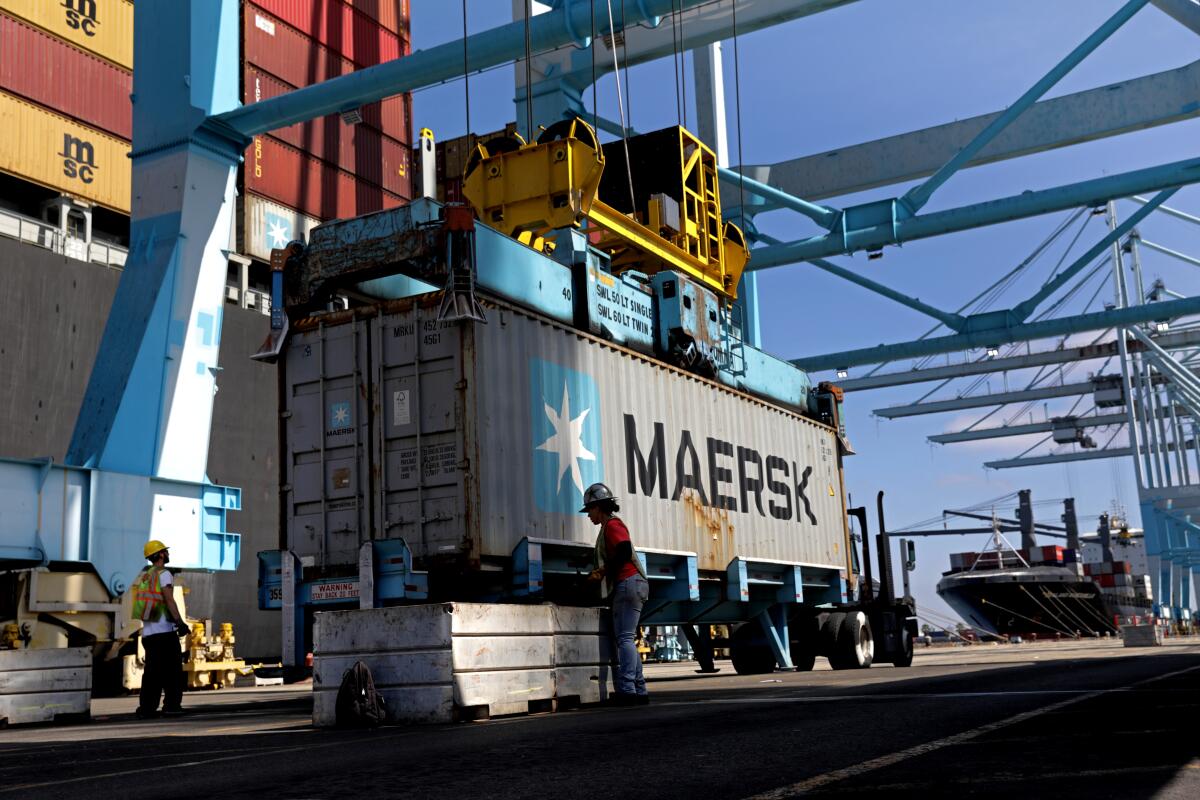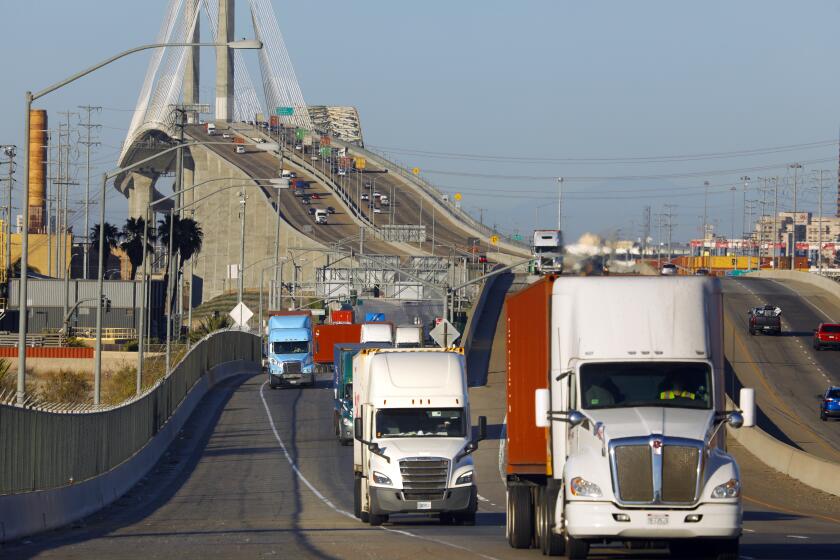Editorial: Port pollution is choking Southern California

- Share via
With smoke-belching container ships, diesel cargo-moving equipment and thousands of polluting trucks, the ports of Los Angeles and Long Beach are the single largest source of pollution in the nation’s smoggiest area.
The communities around the ports have the highest cancer risk from air pollution in the region. And Southern California faces a 2023 deadline to clean up smog but air quality has been getting worse, not better, in recent years.
With so much at stake, why are Los Angeles and Long Beach leaders dragging their feet on cutting emissions?
In 2017, Los Angeles Mayor Eric Garcetti and Long Beach Mayor Robert Garcia pledged to transform the port complex into a zero-emissions facility by 2035. But the region can’t wait 14 years for cleaner air. There’s growing frustration from air quality regulators and environmentalists that the ports — which are seeing record traffic — are not aggressively pushing for cleaner equipment and emissions cuts now.
Case in point: In March 2020, the ports of Los Angeles and Long Beach voted to impose a small fee on shipping containers in order to help truckers buy cleaner vehicles. This fee — $20 on a standard-size container — was modest: It equated to about 1% of the cost to ship a container through the ports and would raise only a fraction of the money needed.
Residents around the ports of L.A. and Long Beach were paid to show support for natural gas trucks at community hearings.
Still, the fee was the first major commitment in the ports’ Clean Air Action Plan. Then the COVID-19 pandemic hit. The ports delayed the fee amid the economic uncertainty. But over the months, global trade rebounded, e-commerce boomed and the ports were inundated with ships and record numbers of cargo containers. Still, the fee was postponed. It now won’t take effect until 2022.
The delay has had real impacts. The incentive program was supposed to encourage drivers to choose zero or near-zero emission models when they replaced their trucks. Instead, about 97% of the old trucks have been replaced by diesel models. Trucks are responsible for 25% of port emissions.
This is a moment when the region should be sprinting to adopt pollution-cutting policies. Southern California has a 2023 deadline to dramatically cut smog-forming emissions to meet Clean Air Act standards. The region will almost certainly miss the deadline and could face hefty federal penalties. There’s another deadline in 2031 that will also be difficult to meet without major emissions reductions starting now.
But the race for cleaner air has been hampered by the reality on the ground. Last year ended up being one of Southern California’s smoggiest years in decades. Climate-change-fueled heat waves and wildfires have worsened air quality. More than 80% of the region’s smog-forming pollution is created by vehicles and equipment that local air quality officials do not directly regulate.
That’s why the South Coast Air Quality Management District is trying more aggressive strategies, including targeting the booming e-commerce and logistics industry. In May, the district passed a first-of-its-kind rule requiring warehouses to reduce pollution by using zero-emission trucks and electric forklifts, installing solar panels, providing chargers for electric vehicles and making other investments.
The district wanted to adopt a similar regulation for the ports. But the district’s governing board, which is made up of elected officials from cities and counties across the region, voted this month to give the ports one last chance to reach a voluntary agreement to clean up port equipment. (The district and port officials have been trying to negotiate an agreement since 2018 with no success.)
It should be clear to Los Angeles and Long Beach leaders that the publicly owned ports have an obligation to step up for public health. During the last nine years, smog-forming emissions from the ports have barely decreased, according to the air district. Meanwhile, ports on the East Coast and in Europe are moving rapidly to roll out zero-emission equipment.
Yes, the ports sit in the middle of a complex web of global trade. But they cannot minimize the impact that the dirty supply chain has on the communities in the shadow of all the ships, trains and trucks. Los Angeles and Long Beach have the ability to push logistics companies and the world’s biggest retailers, including Amazon and Walmart, to clean up their operations faster. Southern California needs results.
More to Read
A cure for the common opinion
Get thought-provoking perspectives with our weekly newsletter.
You may occasionally receive promotional content from the Los Angeles Times.











